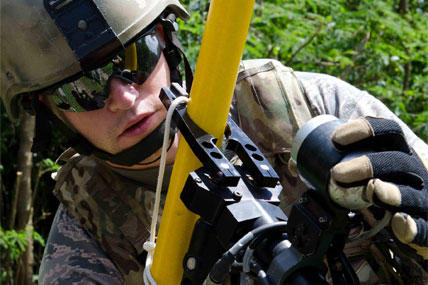ANDERSEN AIR FORCE BASE, Guam -- Team Andersen's Explosive Ordnance Disposal participated in the biennial multinational EOD exercise Tri-Crab 2012 from Aug. 20-31 on and around Guam.
Tri-Crab is a combined engagement that focuses on strengthening relationships within the Asia-Pacific region through training and information exchanges, enhancing EOD and diving-related interoperability. Additionally, the joint exercise aims to prepare participating nations for counterterrorism and down-range operations.
The name Tri-Crab was derived from the EOD occupational badge, commonly referred to as the "crab" within the career field.
"There are three different nations participating in this EOD exercise, hence the name Tri-Crab," said Joshua Singleton, 36th Civil Engineer Squadron EOD contractor.
The main participants in Tri-Crab 2012 include Air Force EOD technicians, technicians with the Republic of Singapore navy, the Royal Australian air force, the Royal Australian navy and the U.S. Navy's EOD Mobile Unit 5.
"This year, we had the same three countries participate," said Master Sgt. Ryan Groves, 36th CES EOD flight chief. "We also have a representative from the Philippines, who wants to bring his company in 2014. We also have the Marines visiting from Okinawa, who are looking to participate in the future."
Exercise participants focused on training and familiarization with various tools and equipment during the first week and conducted a full-blown field training exercise on the second week.
"The exercise went really well for us," said Royal Australian air force Lt. Ryan Kell, EOD officer. "We conducted multiple major clearing operations utilizing our Air Force teams in conjunction with the U.S. Air Force EOD team. Being able to do operations like this that are similar to most environments in the Asia-Pacific area of responsibility is extremely useful."
Scenarios were set on training grounds all around the island, giving participating EOD technicians a chance to conduct both underwater and land operations.
"We've cleared airfields for aircraft to land, while the Navy cleared the shores so that ships can safely dock," said Groves. "We've also trained in clearing towns for weapons caches and improvised explosive devices."
Participating EOD technicians trained with robots, bomb suits, vehicles and equipment utilized in down-range ordnance-disposal and clearing procedures.
The EOD technicians also practiced post-blast forensic collection for intelligence units supporting the exercise.
Singleton said even though the same three nations participate in Tri-Crab biennially, the number of teams and supporting units who accompany these teams may vary in each exercise.
"Australia and Singapore have always participated," said Singleton. "The number of teams each nation provides and how big the exercise turns out depends on multiple factors, including operations tempo, contingency operations, deployments and training."
Kell said that participating in Tri-Crab with the opportunity to learn how different countries' EOD operate helps participating nations work hand-in-hand in austere environments and dangerous situations.
"It is imperative that we can speak the same language and do the job in the same manner in order to ultimately stay safe downrange," said Kell.
Exercises like Tri-Crab 2012 provide a conducive atmosphere for creating rapport and effective learning environments for joint coalition military operations training.
"When we run into our regional partners downrange and we've worked with them in the past, it makes the job a lot easier," said Groves. "We do a lot of joint operations and will continue to do so. These events help further develop our interoperability with all our regional partners."



























